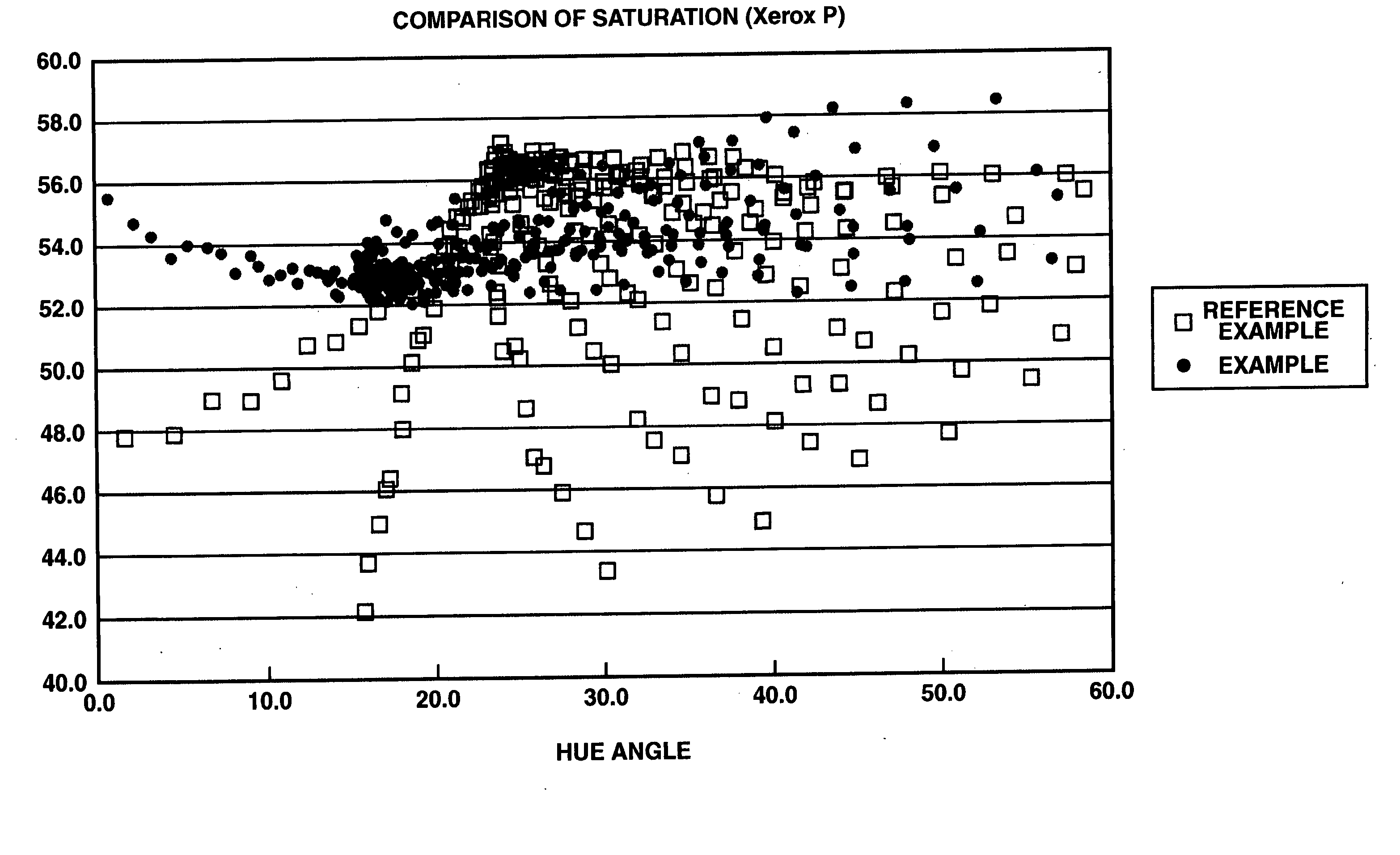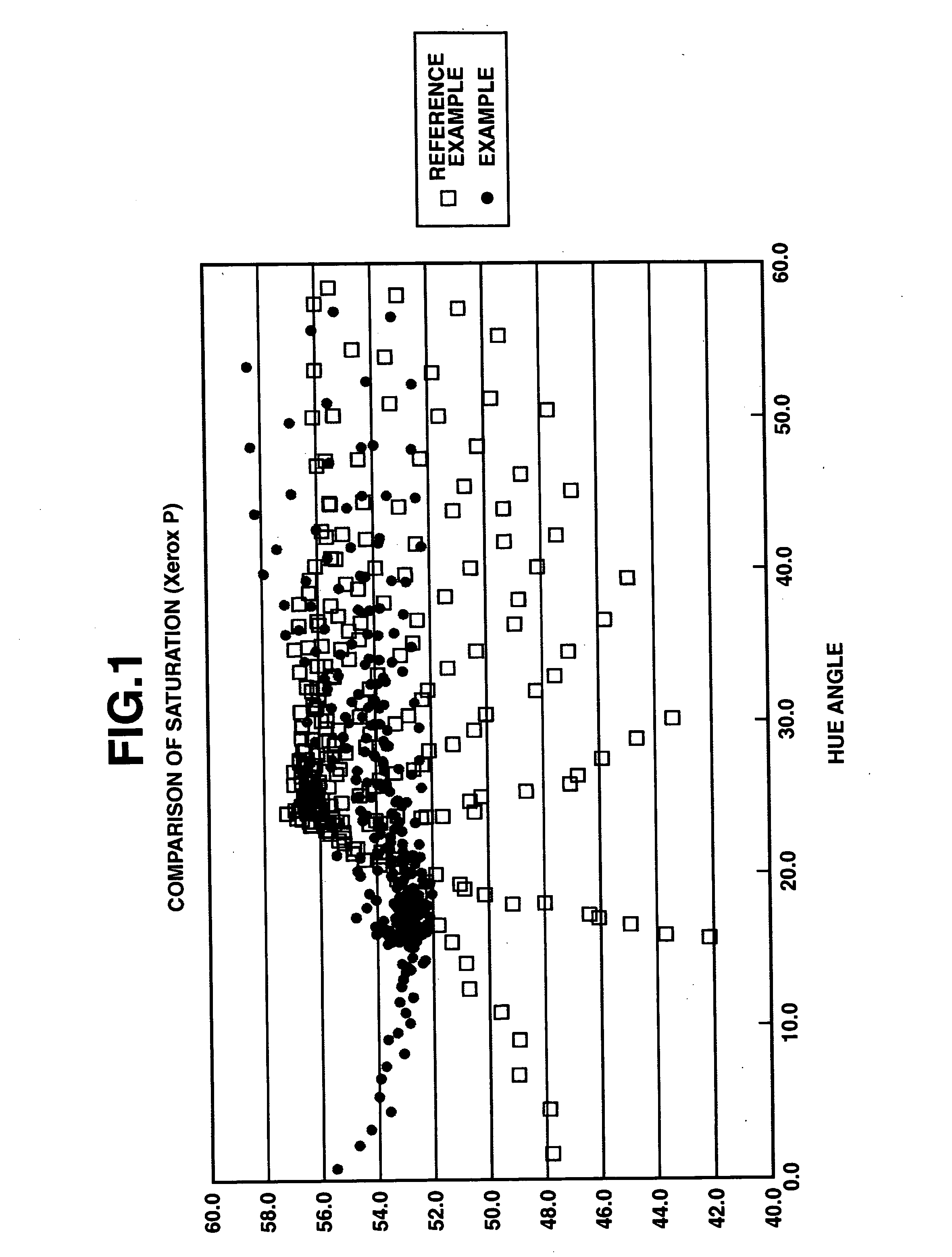Ink set, recording method using the ink set, recording device, recording system, and recorded object
a technology of ink set and recording method, which is applied in the direction of inks, thin material processing, instruments, etc., can solve the problems of reduced gloss, inability to provide printed matter of high image quality, and reduced saturation of printed portions of secondary and higher color, so as to reduce metamerism, reduce fading, and improve the effect of gas resistan
- Summary
- Abstract
- Description
- Claims
- Application Information
AI Technical Summary
Benefits of technology
Problems solved by technology
Method used
Image
Examples
embodiment b
Ink Set of Embodiment B
The ink set of the present invention provides, in another embodiment thereof, an ink set wherein the L* values in the Lab calorimetric system specified by CIE for aqueous solutions of each ink diluted 1000 times are within the ranges of yellow ink (Y): at least 89 and no more than 94, magenta ink (M): at least 76 and less than 83, cyan ink (C): at least 74 and no more than 87, red ink (R): at least 69 and no more than 74 (hereinafter referred to as the ink set of Embodiment B).
In terms of enhancing the effect of the present invention, it is even better for the above-mentioned L* values to be within the following ranges. (Y) L*: 89 to 93, preferably 90 to 93, even more preferably 90 to 92, and especially 91 to 92. (M) L*: 77 to 82, preferably 78 to 82, even more preferably 79 to 82, and especially 81 to 82. (C) L*: 75 to 86, preferably 76 to 85, even more preferably 77 to 83, and especially 79 to 81. (R) L*: 69 to 73, preferably 69 to 72, even more preferab...
embodiment c
Ink Set of Embodiment C
In another embodiment, the present invention provides an ink set wherein the L* values in the Lab colorimetric system specified by CIE for aqueous solutions of each ink diluted 1000 times are within the ranges of yellow ink (Y): at least 89 and no more than 94, magenta ink (M): at least 76 and less than 83, cyan ink (C): at least 74 and no more than 87, red ink (R): at least 62 and less than 67.5 (hereinafter referred to as the ink set of Embodiment C).
In terms of enhancing the effect of the present invention, it is even better for the above-mentioned L* values to be within the following ranges. (Y) L*: 89 to 93, preferably 90 to 93, even more preferably 90 to 92, and especially 91 to 92. (M) L*: 77 to 82, preferably 78 to 82, even more preferably 79 to 82, and especially 81 to 82. (C) L*: 75 to 86, preferably 76 to 85, even more preferably 77 to 83, and especially 79 to 81. (R) L*: 63 to 67, preferably 64 to 67, even more preferably 65 to 67, and especial...
embodiment d
Ink Set of Embodiment D
In another embodiment, the present invention provides an ink set wherein the L* values in the Lab calorimetric system specified by CIE for aqueous solutions of each ink diluted 1000 times are within the ranges of (Y): at least 89 and no more than 94, (M): at least 76 and less than 83, (C): at least 74 and no more than 87, (R): at least 55 and less than 62 (hereinafter referred to as the ink set of Embodiment D).
In terms of enhancing the effect of the present invention, it is even better for the above-mentioned L* values to be within the following ranges. (Y) L*: 89 to 93, preferably 90 to 93, even more preferably 90 to 92, and especially 91 to 92. (M) L*: 77 to 82, preferably 78 to 82, even more preferably 79 to 82, and especially 81 to 82. (C) L*: 75 to 86, preferably 76 to 85, even more preferably 77 to 83, and especially 79 to 81. (R) L*: 55 to 60, preferably 55 to 60, even more preferably 56 to 59, and especially 57 to 58.
Those points not covered in ...
PUM
| Property | Measurement | Unit |
|---|---|---|
| wt % | aaaaa | aaaaa |
| hue angle | aaaaa | aaaaa |
| boiling | aaaaa | aaaaa |
Abstract
Description
Claims
Application Information
 Login to View More
Login to View More - R&D
- Intellectual Property
- Life Sciences
- Materials
- Tech Scout
- Unparalleled Data Quality
- Higher Quality Content
- 60% Fewer Hallucinations
Browse by: Latest US Patents, China's latest patents, Technical Efficacy Thesaurus, Application Domain, Technology Topic, Popular Technical Reports.
© 2025 PatSnap. All rights reserved.Legal|Privacy policy|Modern Slavery Act Transparency Statement|Sitemap|About US| Contact US: help@patsnap.com



